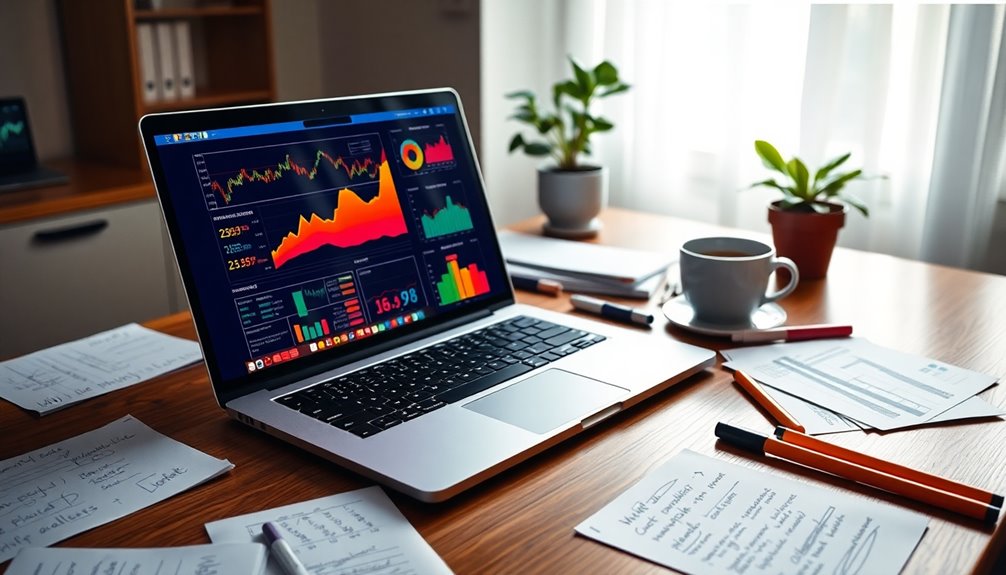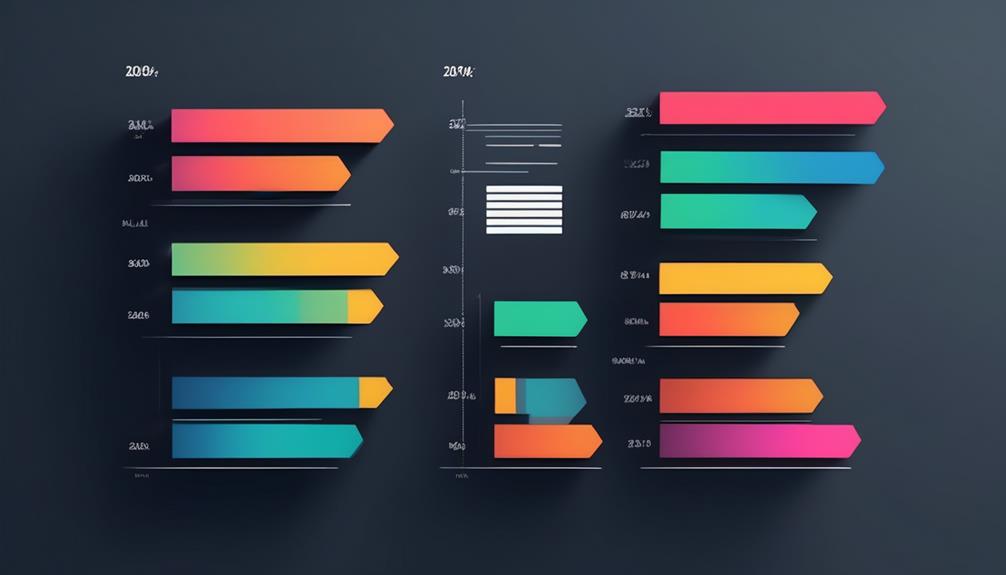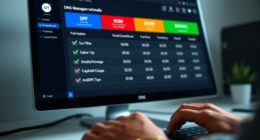If your email analytics seem misleading, it's time to take action. Start by tracking key metrics like open rates, click-through rates, and unsubscribe rates to gain clarity on your audience's behavior. Utilize heatmap analytics to understand where recipients engage most. Don't forget the power of audience segmentation to tailor your messages effectively. Implement A/B testing to refine your strategies based on real data. Continuous monitoring and optimization of your campaigns will keep you ahead. Ready to enhance your email effectiveness and boost engagement? There are more strategies you can explore for even better results.
Key Takeaways
- Regularly track and analyze key engagement metrics like open rates and click-through rates to identify trends and issues in your email campaigns.
- Implement audience segmentation based on demographics and behavior to enhance relevance and improve overall engagement rates.
- Utilize A/B testing to refine subject lines and content, ensuring you accurately identify what resonates with your audience.
- Employ heatmap analytics to visualize recipient interactions, allowing you to adjust content placement for optimal engagement.
- Automate workflows and regularly clean your email list to maintain deliverability and target engaged subscribers effectively.
Understanding Engagement Metrics

Understanding engagement metrics is crucial for optimizing your email marketing strategy, as it helps you gauge how well your messages resonate with your audience.
Start by tracking open rates to see if your subject lines are engaging enough. A/B testing and personalizing those lines can significantly boost your results.
Next, focus on click-through rates (CTR) to measure content effectiveness; segmenting your audience ensures your emails hit the mark. High email engagement signals to mailbox providers that emails are desired, enhancing deliverability.
Click-to-open rates (CTOR) provide deeper insights, so tailor content to preferences through segmentation.
Additionally, monitor read, skim, delete rates to understand interaction levels.
Finally, keep an eye on unsubscribe rates and conversion rates to assess overall campaign health.
Adjust your approach based on these metrics for better engagement and results.
Using Heatmap Analytics

While many marketers focus solely on traditional metrics, incorporating heatmap analytics can significantly enhance your understanding of email engagement.
Heatmaps visualize where recipients interact with your emails, highlighting hot areas—like clicks and hovers—in red and orange, while cooler tones indicate less interest. This insight reveals what content attracts attention and what doesn't. Leveraging user behavior insights from heatmaps allows you to make data-driven decisions that improve overall email performance.
You can optimize your emails by using bullet points and images strategically, as heatmaps show that these elements capture more engagement.
Remember to place important content near the top, as interactions typically drop below the fold.
Segmenting Your Audience

Heatmap analytics provide valuable insights into how recipients interact with your emails, but to truly maximize your engagement, you need to segment your audience effectively.
Start by gathering the right data through sign-up forms, surveys, and purchase history. Focus on actionable information that can drive your marketing strategy.
Next, identify key segmentation criteria like demographics, behavior, and customer lifecycle stages. Create segments starting broadly, then refine them based on specific behaviors. Segmented email campaigns have been shown to have 14.31% higher open rates, underscoring the importance of this strategy. Implementing user-friendly navigation can further enhance the overall experience when directing traffic from your emails to your online store.
For instance, target high-value customers or cart abandoners with tailored messages. Remember, advanced tactics like micro-segmentation and lookalike audiences can yield even better results.
A/B Testing Techniques

A/B testing is a powerful tool that lets you make data-driven decisions to improve your email campaigns. Start by setting clear objectives and formulating specific hypotheses based on your data analysis.
Identify problem areas and establish realistic targets for your tests. When selecting variables to test, focus on elements like subject lines or CTAs, isolating one variable at a time for accurate results. This structured approach ensures that one variable is tested at a time, allowing for clearer insights into which changes drive performance. Additionally, understanding your audience's credit score can help tailor your messaging effectively.
Run your tests with a consistent sample size and allow enough time for data collection. Analyze the results by tracking reliable metrics, identifying what impacts performance, and refining your hypotheses.
Don't forget to iterate your testing process, applying insights gained to continuously enhance your future email campaigns.
Continuous Engagement Monitoring

After refining your email campaigns through A/B testing, it's time to focus on Continuous Engagement Monitoring.
Start by tracking audience interactions—monitor open rates, click rates, and the time subscribers spend reading your emails. This data helps you understand what resonates most.
Analyze campaign performance through detailed reports and trends in subscriber behavior. Incorporating email engagement metrics can provide deeper insights into how your audience is interacting with your content.
Pay attention to unique open rates, bounce rates, and unsubscribe rates to gauge your email's effectiveness.
Use these insights to improve future campaigns with segmentation analysis and personalized content.
High engagement rates enhance your sender reputation and reduce unsubscribe rates.
Regularly analyze your campaigns, making data-driven decisions to keep your audience engaged and your email strategy thriving.
Leveraging Advanced Analytics Tools

As you dive deeper into your email marketing strategy, leveraging advanced analytics tools can significantly enhance your campaign effectiveness.
Tools like Supermetrics and Salesforce Marketing Cloud allow you to create customized reports, providing real-time monitoring of your campaign's performance. You can automate reporting, ensuring your data is consistently updated without extra effort. The importance of email analytics tools lies in enhancing understanding of campaign effectiveness and measuring the ROI of email marketing efforts.
Advanced metrics like open rates and click-through rates help you gauge engagement levels and optimize your content. Additionally, AI-driven insights predict user behavior, enabling you to personalize your email content for better engagement.
Integrating these tools with your CRM gives you a holistic view of customer interactions, ensuring you make informed decisions that drive results.
Embrace these capabilities to elevate your email marketing efforts.
Actionable Insights for Improvement

To enhance your email marketing strategy, it's crucial to focus on actionable insights that drive improvement.
Start by identifying high-purchase intent segments through your email analytics. Target specific campaigns to these segments, increasing your conversion chances.
Use A/B testing to tailor sales approaches based on email engagement, ensuring your content resonates with different customer types. This approach can leverage insights into consumer behavior to better understand what drives customer preferences.
Pay attention to engagement times to refine your content and design, deciding whether visual elements like photos or illustrations are more effective.
Additionally, track trends over time to adjust your strategies and meet evolving customer preferences.
Enhancing Email Strategy Effectiveness

Enhancing your email strategy effectiveness requires a keen focus on personalization and segmentation, ensuring your messages resonate with your audience.
Start by dividing your email list into segments based on demographics and behavior. Utilize dynamic content blocks to tailor messages within the same email, and craft subject lines that highlight recipients' interests.
Optimize your design for mobile devices, using responsive templates and compelling CTAs to boost engagement. Automate repetitive campaigns and create welcome series to maintain customer engagement. Automated workflows can significantly enhance customer journeys and increase conversion rates.
Track key performance metrics to understand your audience's preferences, and adjust strategies based on data-driven insights. Regularly clean your email list to improve deliverability and ensure your emails reach the right people.
Stay proactive in refining your approach!
Frequently Asked Questions
How Can I Improve My Email Subject Lines?
To improve your email subject lines, start by personalizing them with the recipient's name or location.
Keep it concise, avoiding unnecessary words. Use action-oriented verbs to create urgency, and consider posing compelling questions to engage your audience.
Stay current with trends and incorporate curiosity to entice readers.
Finally, be specific with keywords that highlight the email's purpose and connect to what your reader truly needs.
What Are the Best Practices for Email List Maintenance?
Think of your email list like a classic car; it needs regular maintenance to run smoothly.
To keep your lists in shape, clean them frequently using email verification tools, remove inactive subscribers, and monitor soft bounces.
Segment your audience to focus on engaged users, and automate list hygiene to catch those who aren't interacting.
Implementing these best practices ensures your email campaigns remain effective and your audience stays engaged.
How Often Should I Send Marketing Emails?
You should aim to send marketing emails between 10 to 19 times a month for optimal engagement.
This frequency keeps you top-of-mind without overwhelming your subscribers. However, it varies by industry, so consider your audience's preferences.
A/B testing your email cadence can help you find the sweet spot.
Always prioritize personalization and monitor engagement metrics to refine your strategy and ensure your emails resonate with your audience.
What Tools Can I Use for A/B Testing?
Imagine you're a chef, experimenting with flavors to create the perfect dish. For your A/B testing, tools like AB Tasty and Adobe Target can help you taste-test your options.
Statsig is like a sous chef, handling complex recipes, while Split.io provides real-time feedback on your creations.
GrowthBook, an open-source tool, invites a community of chefs to share tips.
Each tool offers unique ingredients to refine your marketing strategy and delight your audience.
How Do I Recover From a High Unsubscribe Rate?
To recover from a high unsubscribe rate, start by analyzing your email data.
Look for patterns in unsubscribe rates alongside open and click-through rates.
Segment your audience to personalize emails, tailoring content to their interests.
Ensure your content is relevant and engaging, using clear headings and concise paragraphs.
Implement best practices, like avoiding no-reply addresses and optimizing preview text.
Regularly assess sending frequency to keep subscribers engaged without overwhelming them.
Conclusion
In the ever-shifting landscape of email marketing, let your insights shine like a lighthouse guiding your strategy. Don't let misleading analytics steer you off course; instead, embrace actionable data to navigate the waves of engagement. By continuously refining your approach with heatmaps, segmentation, and A/B testing, you'll not only enhance your email effectiveness but also cultivate a loyal audience. Remember, every click is a step closer to building lasting connections. Keep your compass pointed toward improvement!










